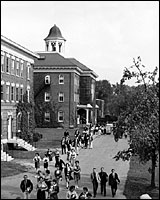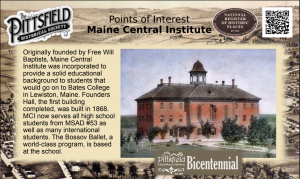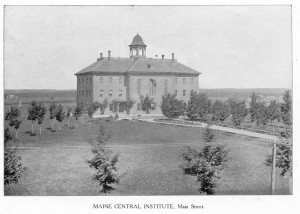 Maine Central Institute
Maine Central Institute
Visit the MCI website for their current history page.
MCI’s History as it appeared in the 2004 MCI website.
“Originally founded by Free Will Baptists, Maine Central Institute was incorporated for the purpose of “feeding” students, equipped with the proper educational background, to Bates College in Lewiston, which was a seminary at that time. MCI’s first catalogue advertised two courses – a “College Preparatory Course” for males and a “Ladies Course,” which did not prepare female graduates for further study. Through the years MCI has established itself as a highly respected private school for students in grades nine through postgraduate, serving all high school age students from Pittsfield, Detroit and Burnham, Maine, as well as students worldwide. MCI’s comprehensive curriculum is designed to meet the varied needs of all of its students.
 “Since the founding of MCI in 1866, the campus has grown tremendously. When the school first opened on August 30, 1866, accommodations for the 32 students were poor. Lectures were held in private homes, public halls and in the village schoolhouse, which stood where the First Baptist Church is today. The campus was literally in a sheep pasture. Today’s picturesque, tree-lined campus consists of four classroom buildings, including the new Chuck and Helen Cianchette Math & Science Center, the library, a music building, two gymnasiums and three residence halls. Approximately 550 students and teaching faculty along with an administration and support staff of 30 fill the campus daily.
“Since the founding of MCI in 1866, the campus has grown tremendously. When the school first opened on August 30, 1866, accommodations for the 32 students were poor. Lectures were held in private homes, public halls and in the village schoolhouse, which stood where the First Baptist Church is today. The campus was literally in a sheep pasture. Today’s picturesque, tree-lined campus consists of four classroom buildings, including the new Chuck and Helen Cianchette Math & Science Center, the library, a music building, two gymnasiums and three residence halls. Approximately 550 students and teaching faculty along with an administration and support staff of 30 fill the campus daily.
“The physical development of the school began in August 1868, when the cornerstone of the Institute Building (later named Founders Hall) was laid. About two years and $40,000 later, the first floor, consisting of six large rooms, was completed. Prior to 1900, many improvements were made in the building: wood stoves in the classrooms were replaced by steam heat; running water and electric lights were installed; “water closets” replaced the privy; and the second and third floors of the building were completed. Llewellyn Powers, an MCI trustee and later governor of Maine, donated money for the remodeling of the upper chapel. Eventually this chapel was remodeled and named Powers Hall, in honor of its key benefactor.
“From 1869 to 1958, the Institute Building served as the only classroom building on MCI’s campus. Today, the Institute Building houses classrooms, the Academic Office and Business Office. Founders Hall is in the process of being restored to its former resplendence as a state-of-the-art educational facility. This is being completed through an annual commitment from the school’s operating budget.
“In 1903, MCI purchased a boarding house from Benjamin Bowden for $1,800, added another story to it, named it Cedar Croft Hall and used it as a girls’ dormitory. Male students lived off campus in private homes and several students commuted daily by train. With the purchase of Cedar Croft Hall, MCI got its start as a boarding school.
“Some major changes came about from 1900 to 1930. Enrollment at the school during World War I increased dramatically and it became necessary to provide more space for residential students. In 1911, at a cost of $22,000, a new girls’ dormitory was erected and later named Weymouth Hall. The construction of the new dormitory made it possible for male students to board in Cedar Croft Hall until 1927 when the wooden structure was destroyed by fire during the Christmas vacation.
“Immediately thereafter, a campaign was initiated by the Alumni/ae to raise money to build a new boys’ dormitory. The drive was successful and in October 1928, the doors of Alumni Hall were opened. The total cost of the new building was $69,889. At a ceremony held at MCI’s 1987 summer reunion, Alumni Hall was rededicated and named Stanley/Alumni Hall in recognition of former Headmaster Edward Stanley.
“The same time period which saw a significant increase in enrollment also witnessed the expansion of MCI’s sports program. Increased interest in sports at MCI began in 1893 when tennis courts were built on the south end of campus. By the early 1900s, baseball, football and track had become part of MCI’s sports program. Realizing the need for a proper athletic field, Mrs. William Hunnewell donated a field to the school in 1915; however, it was sold just a few years later. It wasn’t long, however, before George M. Parks, a distinguished alumnus of the Class of 1885 and devoted trustee, contributed a large sum of money for the development of an athletic field, complete with a cinder tack. The same field is used today for track, football and gym classes. Mr. Parks’ largest gift to MCI came at his death in 1934 when he left approximately $75,000 to the school for the construction of a gymnasium. Completed in 1936 at a cost of $69,000, the George M. Parks Gymnasium continues to serve MCI’s students today.
“In 1944, the John W. Manson House was donated to the school through the will of J.W. Manson. Since that date, it has served as the residence of the headmaster and his family. During World War II, enrollment at MCI plummeted and campus expansion was delayed until the 1950s, when three classroom buildings were added. A Quonset hut was purchased from the government in 1950 and transported to MCI to be used as an industrial arts building. The same year, Mrs. William Powell donated $250,000 to MCI to build and furnish a library “of substantial construction” as a memorial to her husband, the late Judge William H. Powell, Class of 1885. The William H. Powell Memorial Library was the most generous gift the school had ever received to that point, providing students with a beautifully equipped library as well as additional classrooms. The third building constructed at MCI in the 1950s was a building housing science and home economics laboratories. At a price tag of $132,000, funds for the project came primarily from Alumni/ae. The largest contributor to the project was Joseph R. Cianchette, for whom the building is named. The town of Pittsfield also appropriated $50,000 for the building. Also donated through the estate of Lyman Hurd was the Hurd house, which serves as a duplex residence for the dean of students and a faculty member.
“As the postgraduate program became more and more popular in the late fifties, the demand for boarding space began to increase, and the campus continued to grow in leaps and bounds through the next decade. Two new dormitories were erected: Rowe Hall in 1961 and Manson Hall in 1966. Included in Rowe Hall was a dining hall much larger than the one that had been in operation for many years in Weymouth Hall. Another great addition to the school came in 1962 when Johnson W. Parks, nephew to George M. Parks, donated the Parks Homestead, a 200-acre farm on Hartland Avenue, to MCI. Within a year, plans were made for a golf course to be developed on the property. In 1966, the Johnson W. Parks Golf Course was opened to the public. The course has been recognized by the National Golf Foundation as one of the finest nine-hole courses in New England.
“MCI’s music program also received a big boost in the sixties when the school purchased a machine shop from Cianbro Corporation and converted the building into a music center named after Ruth Plummer Cook, who was a renowned music instructor at MCI for many years.
“In 1980, the MCI Commitment Fund was initiated. MCI’s largest capital campaign to that point resulted in the completion of the Wright gymnasium and the renovation of Weymouth Hall. In the fall of 1987, Wright Gymnasium opened and continues to serve as one of Central Maine’s most outstanding athletic facilities. Wright Gym became a reality due largely to the great contributions of the Perley Wright family, especially brothers Clifford ’38 and Carl ’43, the Cianbro Corporation, many donations from Alumni/ae and friends and the local community. In 1988, MCI’s dormitories were renovated and furnished with new carpeting, lighting, doors, desks, wardrobes, beds and chairs. Weymouth Hall now houses the offices of the associate headmaster, the dean of students and social counseling. In addition, classrooms, a learning center, English as a Second Language and the student union make Weymouth Hall the center of campus life.
“In 1992, the former Bryant House on the school campus was renovated. The home has been renamed in recognition of its long-time residents, Ralph and Edna Cianchette and their children. Contributions from individuals and business associates of Ralph and Edna’s children (Carl ’37, Norris ’40, Clair ’41, Kenneth ’42, Ival ’44, Marilyn ’47, and Alton ’48) resulted in the gift to MCI of the Cianchette Alumni and Development Center, which serves as a meeting place for Alumni/ae, friends and other guests of the school as well as office space for the Head of School, Admissions Office and the Alumni and Development Offices.
“Throughout the years, Maine Central Institute has maintained its commitment as an independent secondary school to the students of the local Pittsfield area and its residential population, which includes students from around the globe. The school has been and continues to be an historic landmark and a critical economic and cultural component of life in Pittsfield, Maine.”


